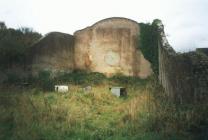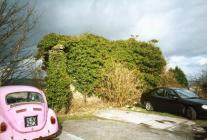Handball: game of the people
Items in this story:
Against the wall - playing handball
In Wales handball was played using a hard, leather-cased ball with the hand against the side of a house, church and, from the 18th century, in an open-backed court usually near a public house. It was played in front of crowds for money prizes and betting.
Played using the palm of the hand, the ball was hit against the front wall before or after it had struck the floor once. Similar to squash without rackets, the object was to keep the ball out of the opponent's reach but inside the bounds of the court. Play continued until a competitor failed to return a ball. Scores were marked on the front wall.
Handball was often referred to as 'fives', for example, in 1744, a Joanna Lond of Swansea was accused of: "maintaining a certain gaming house for a certain unlawful game called fives". In fact, it was more probably handball that was being played.
The letter above, written in 1817, states the author’s objection to the transformation of the courtyard of the church at Llandaff into a 'Fives court', with the game being played against the church wall during services, again this would have been handball not 'Fives'.
It is clear that the more aristocratic ‘Eton fives’ played at grammar schools in Wales was a world away from the 'unlawful', working-class, often professional game of handball that was played mainly throughout Glamorgan.
Nelson Handball Court built c.1860
At Nelson, Glamorgan, the game was first played against a flat wall of the Nelson Inn (now The Village Inn). In c.1860 the landlord of the nearby Royal Oak then constructed a purpose-built court to entice customers from the Nelson. Irish immigrants who were working on the construction of the Great Western (Pontypool Road to Neath line), and Taff Vale Railways which both passed through the village, are thought to have had a hand in the design of this court (handball in Ireland was, and is, a working-class sport played in ‘big alleys’ measuring, like the Nelson court; 60’x30’).
The Nelson court was most famous from 1880 until the Second World War with an annual tournament lasting from May - August, accompanied by much betting. Wire netting was erected in 1913 after the building of nearby Police Station in 1910. Handball is still played there today.
Burrows Court, Jersey Marine
The only other surviving handball court in Wales is Burrows Court in Jersey Marine, Neath. Built by brewery owner Evan Evans in 1864; it has a stone heart set in the highest wall and an inscription which reads: 'Gwrol Galon Hyd Angau' (a brave heart till death). This emblem is that of the 17th Glamorgan Volunteer Rifle Corps who were inaugurated on 2nd June 1860 with Evan Evans as their captain. The corps of 100 men consisted mainly of workers from his brewery. It is thought that the court may have been used as a rifle range for the volunteers’ target practice. Burrows Court was probably the most famous handball court in its day. It was here in 1875 that Dr Ivor Ajax-Lewis, the handball champion for Llantrisant, defeated Mr Lovett, the champion of Neath, in a celebrated match with 1,000 in betting stakes! Other champion handball players were Billy Newnam of Llantrisant and the terrible Treharne twins of Pontypridd.
Other possible courts
The photo above shows the remains of a handball court at the Angel Inn (now Pwysty), Llantrisant. These high-walled, open air handball courts were familiar sights in many other Glamorgan villages in the late 19th century. There are references to handball played near the following public houses:
Old Ynysybwl Inn, Ynysybwl
The Workingmen’s Club, Llantrisant
The Star, Gellidawel
The Globe Inn, Cwmaman
Handball was also played at sites in Merthyr Tydfil, Llancaiach and Tonypandy, and courts remained at Neath, Porth, Llantrisant and Mountain Ash until recent years.
Interest in the game went through a period of decline in the early 20th century as transportation advances made it easier to assemble teams of people for the increasingly popular football games. Although the game was revived during the depressed 1930’s and handball is thought to have been played in Swansea as a street game all over the city, up to the 1960s. As far as is known, the game is only played in Wales now at the Nelson Court, which is the venue for international games.
Story contributed by: RCAHMW
References:
Notes by C. N. Jones (Royal Commission investigator) dated 1969.
H. J. Jones, Nelson Handball Court 1860-1940. History of the Court and its Players.
T. Vaughan Jones: ‘Handball and Fives’ p.22 (unpublished).
John Newman, The Buildings of Wales: Glamorgan, 1995, p573.
http://irishhandballalley.blogspot.com



